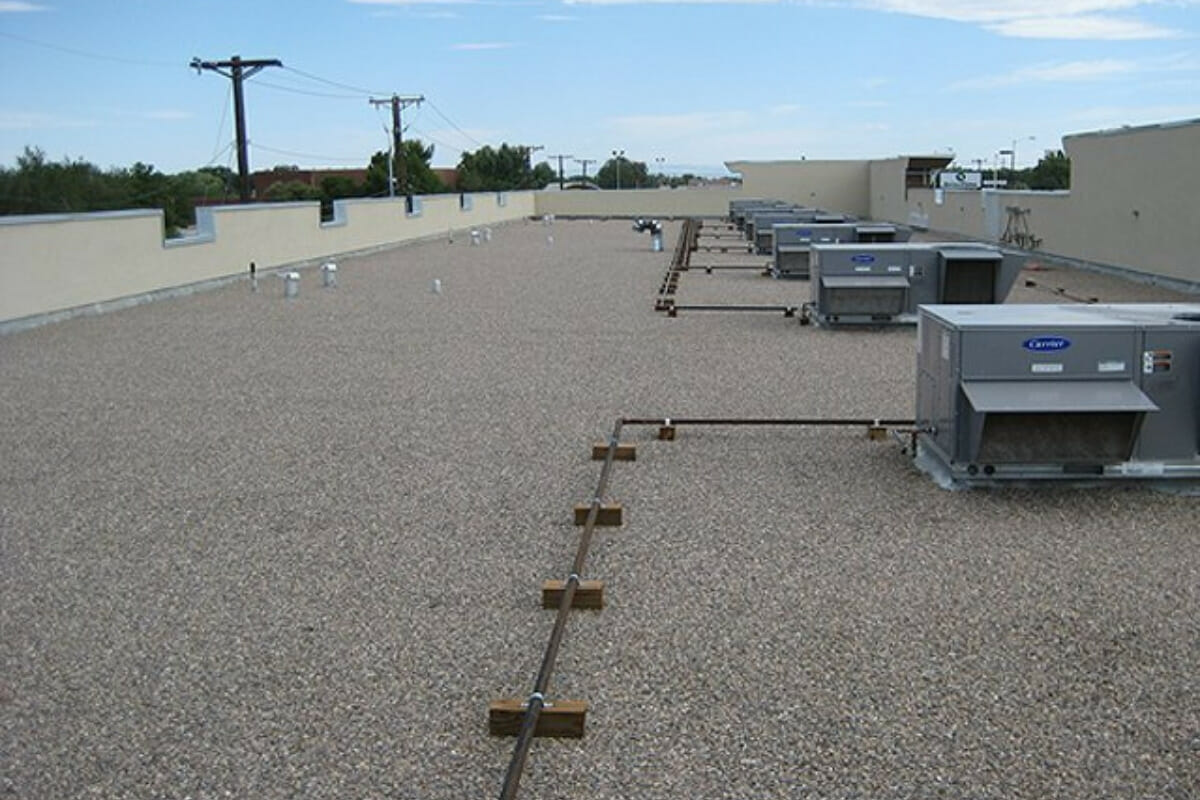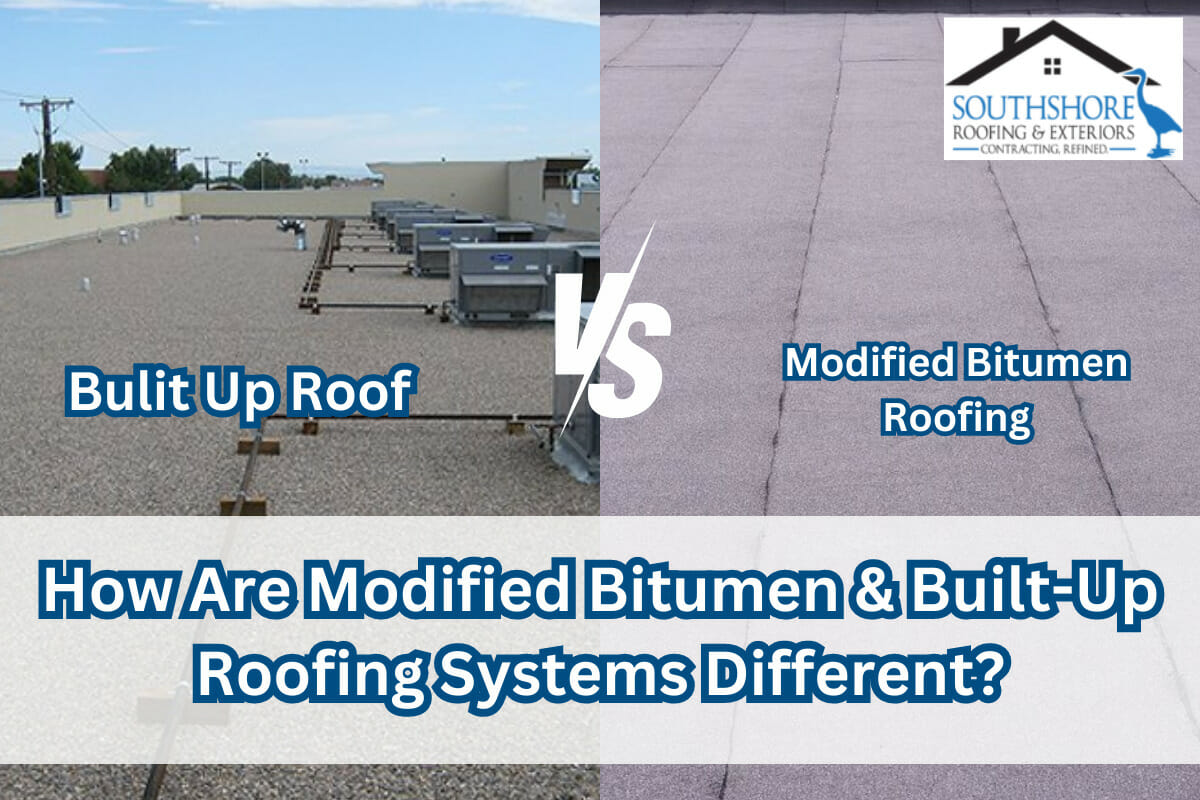When it comes to commercial roofing types in Tampa, there are a variety of options available. Two popular choices are modified bitumen and built-up roofing (BUR) systems. While you may have heard that modified bitumen is a cousin of a BUR, it’s important to learn and understand the differences between them to make an informed decision for your commercial property.
In today’s blog post, we will learn more about both these popular commercial roofing materials, their benefits, and the limitations of each. We will also touch upon other roofing alternatives for your commercial flat roof. So let’s get started.
What is a Modified Bitumen Roof?
Modified bitumen roofing is an asphalt-based roofing system that is designed for low-slope or flat roofing structures. It is also commonly known as a mod-bit roofing system.
The system is made up of two layers: a base sheet and a cap sheet. The base sheet is self-adhered directly to the roofing surface, and the cap sheet can be torched down, self-adhered, or cold-adhered to the base sheet.
The bitumen used in the modified bitumen roofing system is modified with the addition of polymers. These additions are usually classified into two types: styrene butadiene (SBS) and atactic polypropylene (APP). Both materials are elastomeric, meaning they are flexible and are resistant to splitting and fractures.
Benefits Of Modified Bitumen Roofing Systems
Mod bit roofs can offer you several advantages, here are some of the following:
Enhanced Durability
Modified bitumen roofing systems offer enhanced durability compared to traditional asphalt roofs. The inclusion of modifiers, such as APP or SBS, improves the roofing system’s resistance to cracking, splitting, and thermal stress. This durability helps extend the lifespan of the roof and reduces the need for frequent repairs or replacements.
Weather Resistance
Modified bitumen roofing provides excellent weather resistance, making it suitable for various climates and weather conditions. It can withstand extreme temperatures, heavy rain, snow, and hail.
Limitations
Potential Fire Hazard
One of the potential risks associated with modified bitumen roofing systems is the fire hazard that can arise during the torch-down installation method. Torch-down installation involves the use of an open flame torch to melt the bitumen and create a secure bond between the layers of the roofing system. Due to this, there is a risk of accidental fire or property damage.
Complex Methods Of Installation
While DIY installation is possible for some modified bitumen roofing systems, it’s important to note that proper installation requires knowledge and skill, as improper installation can compromise the roof’s performance and durability. This is why it is important to hire a professional flat roofing contractor in Tampa.
Limited Reflectivity:
While modified bitumen roofing systems can offer some degree of reflectivity, they may not provide the same level of energy efficiency as more advanced roofing materials designed specifically for high reflectivity and insulation.

What Is A Built-Up Roof?
Built-up roofing systems are one of the oldest and time-tested methods of roofing. Originating in the 19th century, BUR systems have stood the test of time and continue to be used in various applications today. However, you may see that these have given way to the advanced single-ply roofing materials in Tampa, which we will talk about later in this blog post.
A built-up roofing system is also known as a tar and gravel roof since the top layer of the roof is finished with a stone or gravel coating to create a sealed surface. This roofing style is created by layering multiple plies of bitumen-saturated felt or ply sheets alternated with bitumen and topped with a protective surface material. This technique creates a durable and long-lasting roofing membrane that offers exceptional waterproofing capabilities.
With advancements in technology and the availability of modern materials, built-up roofing systems have evolved to provide an enhanced level of performance.
Advantages Of A Built-Up Roof
Below are the advantages of a built-up roofing system:
Fire Resistant
BURs are highly fire-resistant, making them a safe choice for commercial properties. The multiple layers of bitumen-saturated felt or ply sheets in built-up roofing systems create a fire-resistant barrier. This makes them highly resistant to the spread of fire, providing an added layer of protection to the building and its occupants. In case of a fire, built-up roofing systems can help prevent the fire from spreading.
Enhanced Waterproofing
One of the primary advantages of built-up roofing systems is their excellent waterproofing capabilities. The multiple layers of bitumen and felt create a watertight membrane that effectively prevents water penetration. This helps to protect the underlying structure from moisture damage, including rot, mold, and structural deterioration.
Dense Structure
Built-up roofs have a dense and layered composition, typically consisting of multiple plies of bitumen-saturated felt or ply sheets. This dense structure provides added strength and stability to the roofing system, allowing it to withstand heavy foot traffic during maintenance or repairs without significant damage.

Limitations Of A BUR
Installation Can Take Time
Compared to some other roofing materials common in Tampa, the installation of built-up roofs can be time-consuming. This can be an issue in commercial properties where time is of the utmost importance. As we discussed above, the built-up roof is a combination of layers that involves applying multiple plies of bitumen and saturated felt. This can take longer than the installation of single-ply membranes or other roofing options.
Note that the installation time may vary depending on the size of the roof and the complexity of the building’s design. So make sure to manage your time if you decide to proceed with an installation.
Weight Considerations
Built-up roofing systems can be relatively heavy compared to some alternative roofing materials. The multiple layers of bitumen, felt, and surfacing materials can add significant weight to the roof structure.
This additional weight might require structural reinforcement or evaluation to ensure that the building can adequately support the load of the roofing system.
Maintenance Requirements:
While built-up roofing systems generally require minimal maintenance, they do benefit from periodic inspections and upkeep. Regular inspections can help identify and address any potential issues, such as damaged or worn-out layers, to maintain the roof’s performance.
Depending on the specific materials used and the environmental conditions, built-up roofs may require occasional re-coating or resealing.
Modified Bitumen vs. Built-Up Roof: Points Of Difference
In the section above we talked about both these roofs and their benefits and limitations. Now let’s sum up and cover the points of difference between a modified bitumen and a built-up roof:
| Basis | Modified Bitumen Roof | Built-Up Roof |
| Meaning | Type of a roofing material made with a combination of asphalt and polymerized rubber | A roofing system ‘built up’ with alternating layers of asphalt and felt |
| Other Names | Also known as mod bit roof | Also known as a BUR and a tar and gravel roof |
| Lifespan | 20-25 years | 25-30 years |
| Durability | Good durability | Good durability, and can handle foot traffic and weather conditions better |
| Weight | Lightweight roofing system | It can be heavy depending on the layers |
| Installation | Easier to install than a built-up roof | Complex and time-consuming installation process |
Which Commercial Roofing System is Right for You?
Deciding which commercial roofing system is right for you depends on your specific needs and preferences. Choosing the right commercial roofing material is dependent on several factors such as the following:
Building Type: Evaluate the specific requirements and structural characteristics of your building, such as its size, slope, and architectural design.
Budget: Determine your budget for the roofing project, including its installation, materials, and long-term maintenance costs. Compare the costs associated with modified bitumen and built-up roofing systems.
Maintenance Requirements: Consider the maintenance needs of each roofing system. Assess the frequency and complexity of required maintenance tasks, such as inspections and repairs.
A modified bitumen roof is a good choice if you’re looking for a cost-effective and energy-efficient option that you can install yourself. On the other hand, a built-up roof is a smart investment if you’re looking for a fire-resistant and long-lasting option that requires professional installation.
Regardless of which option you choose, it’s important to properly maintain your commercial roofing system to ensure its longevity and effectiveness.
Other Alternative Roofing Materials For Your Flat Roof
Though they are a popular choice in commercial roofing, built-up roofing, and modified bitumen roofs are not the only options available. Over the years single-ply membrane roofing options have gained attention too, such as TPO and EPDM.
Conclusion
Regardless of the roofing material you choose it is essential that you hire a professional roofing contractor to install it on your flat roof.
If you are looking to upgrade your commercial roof, then our team at SouthShore Roofing & Exteriors can come to your aid. We have years of experience installing and replacing commercial roofing systems in Tampa and surrounding areas.
Contact us today at (813) 400-3329 to book a free roof inspection!




